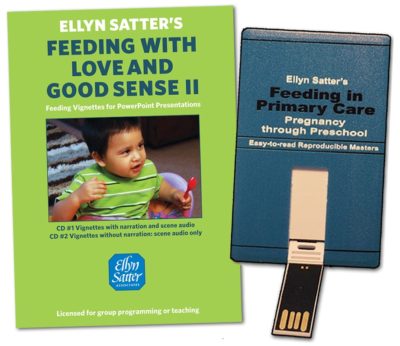Ellyn Satter’s Feeding With Love and Good Sense II Waiting Room English
$100.00
Repeating-loop program of close-up, compelling footage of real parents and real children in their homes in actual feeding situations reveals what works and what doesn’t with feeding. Introduce parents and other practitioners to the possibilities of following the division of responsibility in feeding by setting up a continuous loop viewer in your waiting room! Your audience will identify with what they see and have their understanding and questions stimulated by these up-close, tuned-in videos. Adapted from Ellyn Satter’s Feeding with Love and Good Sense II DVD. Breastfeeding has been screened and vignettes modified for clarity of content.
Video samples:
Stimulate your parents' awareness and questions while they wait to see you! These compelling videos of real parents and real children show what to do - and not do - with feeding. Adapted from Ellyn Satter’s Feeding with Love and Good Sense II DVD. Breastfeeding has been screened and vignettes modified for clarity of visual content. Four 15- minute segments, each containing vignettes of four to six families created, produced, and narrated by internationally-recognized feeding authority Ellyn Satter. Parents who volunteered to be videoed for this project represent a variety of ethnic groups and income levels.
The Infant: Your baby eats best when you get on the same wavelength and understand what she tells you about her eating and sleeping. Keep figuring things out with your baby until you both get your needs met - yours to nurture and hers to be nurtured.
The Transitional Child: Midway in her first year, your baby starts working her way from learning to eat semi-solid food from the spoon to joining in with family meals. Guide feeding by what your baby does, not her age. Give plenty of chances to learn, have fun, and let her eat whether and how much she wants.
The Toddler: The toddler is picky, does not eat as much as he did earlier, eats a lot one time and hardly anything another, and is skeptical of even-familiar foods. To do well with eating, your child needs structure, opportunities to learn, and no pressure. Do your jobs, then settle for however much - or little - he eats.
The Preschooler: If you do your feeding jobs and let your preschooler do his eating jobs, he will be a competent eater. But because he wants to please you, you can get your preschooler to eat more, less, or different foods than he wants. Don’t do it! In the long run, it will make him eat worse, not better.
Additional information
| Weight | 0.4 lbs |
|---|---|
| Dimensions | 5.25 × 4.75 × .5 in |


Reviews
There are no reviews yet.